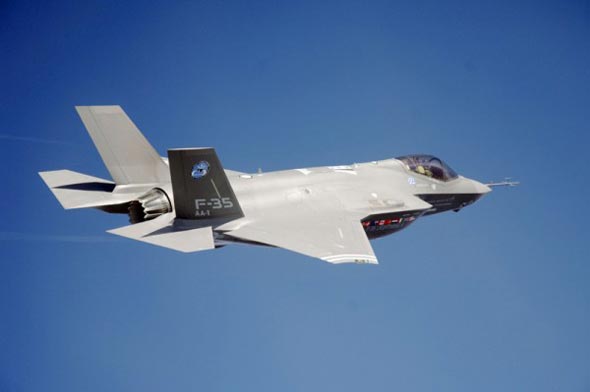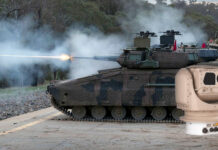Israel Defense Forces Chief of Staff Gabi Ashkenazi approved today (Sept 3rd, 2007) the Israel defense Forces (IDF) five year military procurement plan under the codename “TEFEN 2012” projecting expenditure of US$60 billion over five years between 2008 and 2012. The program reflects the IDF’s utilization of the increased US military aid supporting about 75% of the program. The US$30 Billion additional military aid to be allocated over 10 years was committed by the USA last month to support Israel’s military buildup will play an instrumental role in the new revitalization program and, will most probably influence some of the IDF procurement decisions. TEFEN will be submitted to government approval by January 2008.
For the first time in over a decade, the IDF make significant investment in its land forces, as it plans to field hundreds of new Merkava Mk4 tanks, heavy armored personnel fighting vehicles, command and control elements and a wide range of unmanned systems.
Strategic investments in Intelligence, Reconnaissance and Surveillance (ISR) will constitute a major element in TEFEN, as ISR programs are expected to proceed at an even higher pace, facing the growing risk of escalation and destabilization in the region. Assets will include aerial (manned and unmanned) platforms, spaceborne and electronic surveillance means. Furthermore, Israel is expected expand its missile defensive systems, introducing enhanced Arrow 3 ballistic missile interceptors, which will enhance the current ‘Homa’ program preparing to face the imminent unconventional threat from Iran, anticipated by the end of this decade. The program is funding continued development of the ‘Magic Wand’ medium range missile interceptor, currently under development in a joint Israeli-US program. TEFEN seeks accelerating development and potential fielding of the ‘Iron Cap’ Counter Rocket, Artillery and Mortar (C-RAM) system, which is expected to be ready for operational use within 24 months.
The shift toward the land forces is reflecting some of the lessons learned from the 2nd lebanon War, where Israel’s land forces experienced operational problems especially in land forces employment following years of neglect and erosion in equipment modernization and training scheduled. During the last years, while operational focus was diffused by continuous low-intensity warfare in the occupied territories, which gave national priorities to small unit counter-insurgency tactics and equipment.

One of the significant elements of the five year program is the reconstitution of maneuver warfare as part of the IDF operational capability, realizing the threats and limitations imposed by modern weapons and asymmetric warfare tactics. Acquisition and upgrading of hundreds of new armored personnel carriers, primarily Merkava based Namer AIFVs (shown in the image above) will strengthen the infantry brigades, enabling them to move and fight over any terrain facing high threat levels in fire saturated environment. The absence of such vehicles severely hampered IDF maneuverability and mobility during last year’s Lebanon war, necessitating the use of Merkava tanks to operate under severe tactical inferiority conditions, lacking adequate protection, mainly operating in unsuitable infantry support when tasked with troop mobility, resupply and medical evacuation missions, pitted against 3rd and 4th generation anti-tank missiles.
Production of Merkava Mk4 tanks will continue as planned, adding hundreds of tanks throughout 2012. These tanks will eventually replace all Merkava Mk 2 tanks currently stored for reserve units. The Ground Forces Command will establish a new divisional headquarters, adding more flexibility to the tactical command structure. However, the IDF is not expected to establish new units under the current buildup plan. In addition, Israel will continue to produce Merkava 4 tanks. Both Merkava and Namer will receive new active protection systems (APS) which will dramatically enhance their protection against advanced anti-tank threats. Unlike passive and reactive armor, APS will provide all-round protection to the vehicles, making them useful in asymmetric battle, as well as in high intensity conflict. APS will also be provided to other tanks, including Merkava Mk 3, some Mk2s and other heavy APCs.

While some of the funding foreseen by the Israel Air and Space Force (IASF) will be redirected to the land and naval arms, the Air Force will still receive major influx of new systems including some of the latest air assets. The new program confirms, for the first time, the IDF plans to buy up to 100 F-35 Lightning II strike fighters (photo above). Within the scope of the current five years plan, the IASF will be able to commit to procurement of a first line fighter squadron, purchasing the first batch of 25 aircraft, air/air and precision strike weaponry and support systems. If the IASF makes its decision quickly enough, the first aircraft could be delivered by 2014. The IASF will also receive funding to upgrade its existing aircraft arsenal; included are plans for avionics upgrades of all F-16C/D fighters, bringing them to the Block 50/52 (F-16I) level and possible upgrades for the F-15 fleet. However, due to budgetary constraints the IASF will have to postpone the procurement of new aerial refueling and transport aircraft, which are rapidly aging and therefore increasingly expensive to maintain. Since the operating budgets of refueling assets are funded separately, the IASF may consider alternative options, including outsourcing of aerial refueling services using Gulfstream G550 or Boeing platforms.
The Israel Navy (IN) will receive ‘green light’ committing to the construction of two Littoral Combat Ships, which will probably be used as command ships for two naval task forces, combining surface and subsurface elements including Dolphin submarines, Saar V corvettes, improved Saar IV missile boats and unmanned surface vessels. The navy will also receive new air defense systems, most probably, derivatives of the joint Israeli-Indian Barak-8 development program.

















